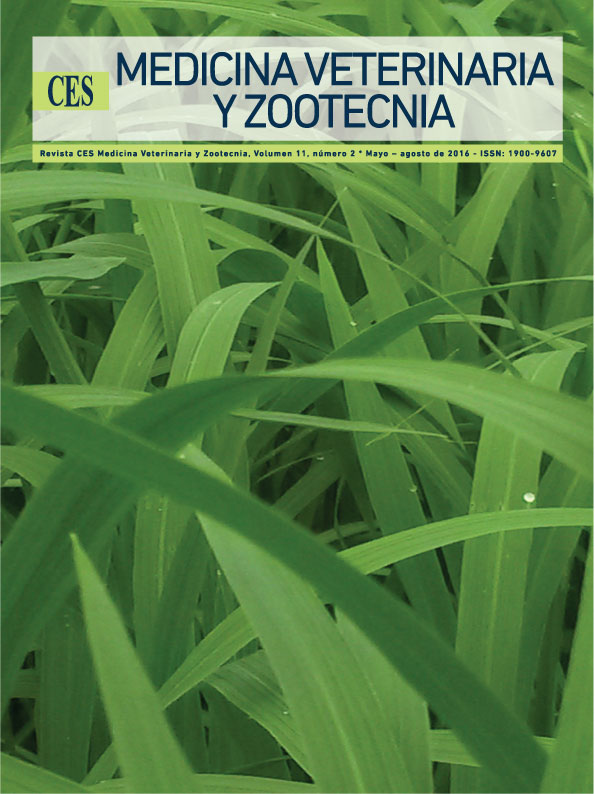Dermatological diseases of nutritional origin in pets: a review
Abstract
The skin pathologies of nutritional origin either due to alterations in intestinal absorption of some nutrients or genetic predispositions affecting its absorption; nutritional deficiencies may occur by poor development of both home and commercial diets; although at present are not as common for the regulation of food is balanced and demands by control agencies in each country. These conditions are related to some vitamins such as A, D, E and C, essential fatty acids, proteins, and certain minerals such as zinc. Among dermatological diseases and clinical signs include food allergies, dry and oily seborrhea, scaling, follicular plugging, hair loss and dull, dry coat, among others. The aim of this review is closer to the vet to the causes of dermatologic disease of nutritional origin clinical, since alterations of the skin in general are very common in the veterinary clinic for small animals and we need to recognize all the pathologies and treat appropriately.
Downloads
References
Miller WH, Griffin CE, Campbell KL, Muller GH, Scott DW. Muller & Kirk’s small animal dermatology. 7th ed. St. Louis, Mo: Elsevier; 2013. 938 p. http://store.elsevier.com/Muller-and-Kirks-Small-Animal-Dermatology/William-Miller/isbn-9781416000280/
Pibot P, Biourge V, Elliot D. Enciclopedia de la Nutrición Clínica Canina. Primera Ed. Paris: Aniwa SAS; 2006. 517 p. http://www.ivis.org/advances/rc_es/A4312.0708.ES.pdf?LA=2
Gaschen FP, Merchant SR. Adverse Food Reactions in Dogs and Cats. Veterinary Clinics of North America: Small Animal Practice [Internet]. 2011 Mar [cited 2015 Mar 18];41(2):361–79. Available from: http://linkinghub.elsevier.com/retrieve/pii/S0195561611000246.
Ricci R, Granato A, Vascellari M, Boscarato M, Palagiano C, Andrighetto I, et al. Identification of undeclared sources of animal origin in canine dry foods used in dietary elimination trials. Journal of Animal Physiology and Animal Nutrition [Internet]. 2013 May;97 Suppl 1:32–8. Available from: http://www.ncbi.nlm.nih.gov/pubmed/23639015.
Hensel P. Nutrition and skin diseases in veterinary medicine. Clinics in Dermatology [Internet]. 2010 Nov;28(6):686–93. Available from: http://linkinghub.elsevier.com/retrieve/pii/S0738081X10000556.
Kirby NA, Hester SL, Bauer JE. Dietary fats and the skin and coat of dogs. Journal of the American Veterinary Medical Association [Internet]. 2007 Jun;230(11):1641–4. Available from: http://www.ncbi.nlm.nih.gov/pubmed/17542730.
Stehle ME, Hanczaruk M, Schwarz SCN, Göbel TW, Mueller RS. Effects of polyunsaturated fatty acids on isolated canine peripheral blood mononuclear cells and cytokine expression (IL-4, IFN-γ, TGF-β) in healthy and atopic dogs. Veterinary Dermatology [Internet]. 2010 Feb [cited 2015 Jun 19];21(1):113–8. Available from: http://doi.wiley.com/10.1111/j.1365-3164.2009.00860.x
Rees CA, Bauer JE, Burkholder WJ, Kennis RA, Dunbar BL, Bigley KE. Effects of dietary flax seed and sunflower seed supplementation on normal canine serum polyunsaturated fatty acids and skin and hair coat condition scores. Veterinary Dermatology [Internet]. 2001 Apr;12(2):111–7. Available from: http://www.ncbi.nlm.nih.gov/pubmed/11360337
Singh SK, Dimri U, Saxena SK, Jadhav RK. Therapeutic management of canine atopic dermatitis by combination of pentoxifylline and PUFAs: Treatment of CAD with pentoxifylline and PUFAs. Journal of Veterinary Pharmacology and Therapeutics [Internet]. 2010 Oct [cited 2015 Jun 19];33(5):495–8. Available from: http://doi.wiley.com/10.1111/j.1365-2885.2009.01146.x
Miller WH. Muller & Kirk’s small animal dermatology. 7th ed. St. Louis, Mo: Elsevier; 2013. 938 p. http://store.elsevier.com/Muller-and-Kirks-Small-Animal-Dermatology/William-Miller/isbn-9781416000280/
Gaschen FP, Merchant SR. Adverse Food Reactions in Dogs and Cats. Veterinary Clinics of North America - Small Animal Practice [Internet]. Elsevier Ltd; 2011;41(2):361–79. Available from: http://dx.doi.org/10.1016/j.cvsm.2011.02.005
Harvey RG. Food allergy and dietary intolerance in dogs: A report of 25 cases. Journal of Small Animal Practice. 1993;34(4):175–9. http://onlinelibrary.wiley.com/doi/10.1111/j.1748-5827.1993.tb02647.x/abstract
Verlinden A, Hesta M, Millet S, Janssens GPJ. Food allergy in dogs and cats: a review. Critical reviews in food science and nutrition. 2006;46(3):259–73. http://www.ncbi.nlm.nih.gov/pubmed/16527756
Martín A, Sierra MP, González JL, Arévalo MA. Identification of allergens responsible for canine cutaneous adverse food reactions to lamb, beef and cow’s milk. Veterinary Dermatology. 2004;15(6):349–56. http://www.ncbi.nlm.nih.gov/pubmed/15585009
Leistra M, Willemse T. Double-blind evaluation of two commercial hypoallergenic diets in cats with adverse food reactions. Journal of Feline Medicine and Surgery [Internet]. 2002 Dec;4(4):185–8. Available from: http://www.ncbi.nlm.nih.gov/pubmed/12468310.
Singh SK, Dimri U, Saxena SK, Jadhav RK. Therapeutic management of canine atopic dermatitis by combination of pentoxifylline and PUFAs: Treatment of CAD with pentoxifylline and PUFAs. Journal of Veterinary Pharmacology and Therapeutics [Internet]. 2010 Oct [cited 2015 Mar 10];33(5):495–8. Available from: http://doi.wiley.com/10.1111/j.1365-2885.2009.01146.x
Olivry T, Kurata K, Paps JS, Masuda K. A blinded randomized controlled trial evaluating the usefulness of a novel diet (aminoprotect care) in dogs with spontaneous food allergy. The Journal of Veterinary Medical Science / the Japanese Society of Veterinary Science [Internet]. 2007 Oct;69(10):1025–31. Available from: http://www.ncbi.nlm.nih.gov/pubmed/17984589.
Loeffler A, Soares-Magalhaes R, Bond R, Lloyd DH. A retrospective analysis of case series using home-prepared and chicken hydrolysate diets in the diagnosis of adverse food reactions in 181 pruritic dogs. Veterinary Dermatology [Internet]. 2006 Aug;17(4):273–9. Available from: http://www.ncbi.nlm.nih.gov/pubmed/16827671.
Tapp T, Griffin C, Rosenkrantz W, Muse R, Boord M. Comparison of a commercial limited-antigen diet versus home-prepared diets in the diagnosis of canine adverse food reaction. Veterinary Therapeutics: Research in Applied Veterinary Medicine [Internet]. 2002;3(3):244–51. Available from: http://www.ncbi.nlm.nih.gov/pubmed/12447831.
Loeffler A, Lloyd DH, Bond R, Kim JY, Pfeiffer DU. Dietary trials with a commercial chicken hydrolysate diet in 63 pruritic dogs. The Veterinary Record [Internet]. 2004 Apr;154(17):519–22. Available from: http://www.ncbi.nlm.nih.gov/pubmed/15134164.
Jackson HA, Jackson MW, Coblentz L, Hammerberg B. Evaluation of the clinical and allergen specific serum immunoglobulin E responses to oral challenge with cornstarch, corn, soy and a soy hydrolysate diet in dogs with spontaneous food allergy. Veterinary Dermatology. 2003;14(4):181–7. http://www.ncbi.nlm.nih.gov/pubmed/12895222
Taliercio E, Loveless TM, Turano MJ, Kim SW. Identification of epitopes of the β subunit of soybean β-conglycinin that are antigenic in pigs, dogs, rabbits and fish. Journal of the Science of Food and Agriculture [Internet]. 2014 Aug;94(11):2289–94. Available from: http://www.ncbi.nlm.nih.gov/pubmed/24415270.
Fogel F, Manzuc P. Dermatología canina para la práctica clínica diaria. Buenos Aires: Intermédica; 2009. 560 p. http://catalogosuba.sisbi.uba.ar/vufind/Record/201603170441122879
Hall J. Diagnostic dermatology. Zinc responsive dermatosis. The Canadian Veterinary Journal La Revue Vétérinaire Canadienne [Internet]. 2005 Jun;46(6):555–7. Available from: http://www.ncbi.nlm.nih.gov/pmc/articles/PMC2831602/
Gross TL, Gross TL, editors. Skin diseases of the dog and cat: clinical and histopathologic diagnosis. 2nd ed. Ames, Iowa: Blackwell Science; 2005. 932 p. http://www.wiley.com/WileyCDA/WileyTitle/productCd-0632064528.html
Outerbridge CA. Cutaneous manifestations of internal diseases. The Veterinary Clinics of North America Small Animal Practice [Internet]. 2013 Jan;43(1):135–52. Available from: http://www.ncbi.nlm.nih.gov/pubmed/23182329.
McEwan NA, McNeil PE, Thompson H, McCandlish IA. Diagnostic features, confirmation and disease progression in 28 cases of lethal acrodermatitis of bull terriers. The Journal of Small Animal Practice [Internet]. 2000 Nov;41(11):501–7. Available from: http://www.ncbi.nlm.nih.gov/pubmed/11105789.
Jezyk PF, Haskins ME, MacKay-Smith WE, Patterson DF. Lethal acrodermatitis in bull terriers. Journal of the American Veterinary Medical Association [Internet]. 1986 Apr;188(8):833–9. Available from: http://www.ncbi.nlm.nih.gov/pubmed/3710872.
Smits B, Croft DL, Abrams-Ogg ACG. Lethal Acrodermatitis in Bull Terriers: A Problem of Defective Zinc Metabolism. Veterinary Dermatology [Internet]. 1991 Jun [cited 2015 Nov 25];2(2):91–5. Available from: http://doi.wiley.com/10.1111/j.1365-3164.1991.tb00115.x.
Grider A, Mouat MF, Mauldin EA, Casal ML. Analysis of the liver soluble proteome from bull terriers affected with inherited lethal acrodermatitis. Molecular Genetics and Metabolism [Internet]. 2007 Nov [cited 2015 Nov 25];92(3):249–57. Available from: http://linkinghub.elsevier.com/retrieve/pii/S1096719207002387.
PJ I, MH G. Vitamin A-responsive dermatosis in the dog. J Am Vet Med Assoc ; 1983;182:687–90.
Bonagura JD, Kirk RW. Kirk’s current veterinary therapy 14. Philadelphia, Pa.; London: Elsevier Saunders; 2008.
Scott DW, Muller GH, Kirk RW, Miller WH, Griffin CE. Muller & Kirk’s small animal dermatology. Philadelphia: W.B. Saunders; 2001.
Lam ATH, Affolter VK, Outerbridge CA, Gericota B, White SD. Oral vitamin A as an adjunct treatment for canine sebaceous adenitis: Vitamin A for canine sebaceous adenitis. Veterinary Dermatology [Internet]. 2011 Aug [cited 2015 Jun 19];22(4):305–11. Available from: http://doi.wiley.com/10.1111/j.1365-3164.2010.00944.x.
Nishikimi M, Kawai T YK. Guinea pigs possess a highly mutated gene for L-gulono-gamma-lactone oxidase, the key enzyme for L-ascorbic acid biosynthesis missing in this species. J Biol Chem. 1992;267(30):21967–72. http://www.ncbi.nlm.nih.gov/pubmed/1400507
Scott DW, Sheffy BE. Dermatosis in dogs caused by Vitamin E deficiency. Comp Anim Pract. 1987;1:42–6. http://eurekamag.com/research/001/560/001560168.php
Plevnik Kapun A, Salobir J, Levart A, Tav ar Kalcher G, Nemec Svete A, Kotnik T. Vitamin E supplementation in canine atopic dermatitis: improvement of clinical signs and effects on oxidative stress markers. Veterinary Record [Internet]. 2014 Dec [cited 2015 Mar 12];175(22):560–560. Available from: http://veterinaryrecord.bmj.com/cgi/doi/10.1136/vr.102547.
Mathews CK, Van Holde KE, Ahern KG, González de Buitrago JM. Bioquímica. Madrid: Addison Wesley; 2002.
Müller MR, Linek M, Löwenstein C, Röthig A, Doucette K, Thorstensen K, et al. Evaluation of cyclosporine-sparing effects of polyunsaturated fatty acids in the treatment of canine atopic dermatitis. The Veterinary Journal [Internet]. Elsevier Ltd; 2016;210:77–81. Available from:http://linkinghub.elsevier.com/retrieve/pii/S1090023315004967.
Mueller RS, Fieseler K V, Fettman MJ, Zabel S, Rosychuk R a W, Ogilvie GK, et al. Effect of omega-3 fatty acids on canine atopic dermatitis. The Journal of small animal practice. 2004;45(6):293–7. http://www.ncbi.nlm.nih.gov/pubmed/15206474
Abba C, Mussa PP, Vercelli A, Raviri G. Essential fatty acids supplementation in different-stage atopic dogs fed on a controlled diet. Journal of animal physiology and animal nutrition [Internet]. 2005 [cited 2015 Jun 19];89(3-6):203–7. Available from: http://onlinelibrary.wiley.com/doi/10.1111/j.1439-0396.2005.00541.x/full.
Tretter S, Mueller RS. The influence of topical unsaturated fatty acids and essential oils on normal and atopic dogs. Journal of the American Animal Hospital Association [Internet]. 2011 Aug;47(4):236–40. Available from: http://www.ncbi.nlm.nih.gov/pubmed/21673338.
Vaughn, D.M., Reinhart, G.A., Swaim, S.F., Lauten, S.D., Garner, C.A., Boudreaux MK, Spano, J.S., Hoffman, C.E., Conner B. Evaluation of effects of dietary n-6 to n-3 fatty acid ratios on leukotriene B synthesis in dog skin and neutrophils. Veterinary Dermatology. 1994;5:163–73. http://onlinelibrary.wiley.com/doi/10.1111/j.1365-3164.1994.tb00028.x/abstract
Olivry T, Mueller RS. Evidence-based veterinary dermatology: a systematic review of the pharmacotherapy of canine atopic dermatitis. Veterinary dermatology [Internet]. 2003 [cited 2015 Jun 19];14(3):121–46. Available from: http://onlinelibrary.wiley.com/doi/10.1046/j.1365-3164.2003.00335.x/pdf.
Saevik BK, Bergvall K, Holm BR, Saijonmaa-Koulumies LE, Hedhammar A, Larsen S, et al. A randomized, controlled study to evaluate the steroid sparing effect of essential fatty acid supplementation in the treatment of canine atopic dermatitis. Veterinary Dermatology [Internet]. 2004 Jun;15(3):137–45. Available from: http://www.ncbi.nlm.nih.gov/pubmed/15214949.
Bensignor E, Morgan DM, Nuttall T. Efficacy of an essential fatty acid-enriched diet in managing canine atopic dermatitis: a randomized, single-blinded, cross-over study. Veterinary Dermatology [Internet]. 2008 Jun [cited 2015 Jun 19];19(3):156–62. Available from: http://doi.wiley.com/10.1111/j.1365-3164.2008.00670.x.
Popa I, Pin D, Remoué N, Osta B, Callejon S, Videmont E, et al. Analysis of epidermal lipids in normal and atopic dogs, before and after administration of an oral omega-6/omega-3 fatty acid feed supplement. A pilot study. Veterinary Research Communications [Internet]. 2011 Dec [cited 2015 Jun 19];35(8):501–9. Available from: http://link.springer.com/10.1007/s11259-011-9493-7.
Watson AL, Fray TR, Bailey J, Baker CB, Beyer SA, Markwell PJ. Dietary constituents are able to play a beneficial role in canine epidermal barrier function. Experimental Dermatology [Internet]. 2006 Jan;15(1):74–81. Available from: http://www.ncbi.nlm.nih.gov/pubmed/16364034.
Blaskovic M, Rosenkrantz W, Neuber A, Sauter-Louis C, Mueller RS. The effect of a spot-on formulation containing polyunsaturated fatty acids and essential oils on dogs with atopic dermatitis. The Veterinary Journal [Internet]. 2014 Jan [cited 2015 Jun 19];199(1):39–43. Available from: http://linkinghub.elsevier.com/retrieve/pii/S1090023313005388.
Kirby NA, Hester SL, Rees CA, Kennis RA, Zoran DL, Bauer JE. Skin surface lipids and skin and hair coat condition in dogs fed increased total fat diets containing polyunsaturated fatty acids. Journal of Animal Physiology and Animal Nutrition [Internet]. 2009 Aug [cited 2015 Jun 19];93(4):505–11. Available from: http://doi.wiley.com/10.1111/j.1439-0396.2008.00832.x.
Downloads
Published
How to Cite
Issue
Section
| Article metrics | |
|---|---|
| Abstract views | |
| Galley vies | |
| PDF Views | |
| HTML views | |
| Other views | |



